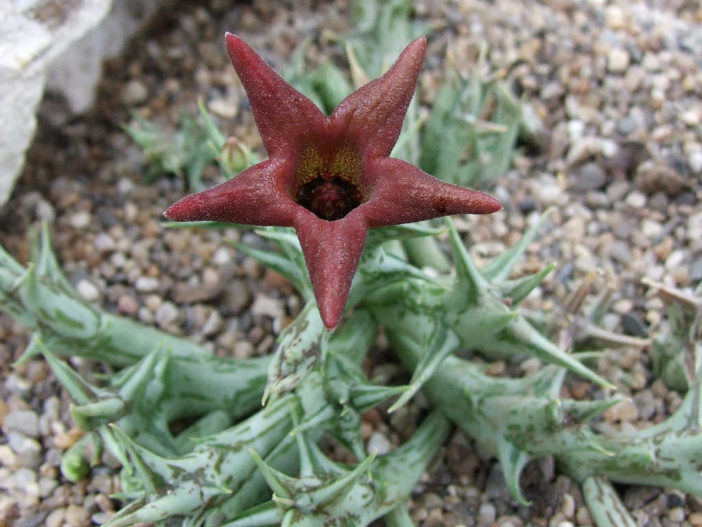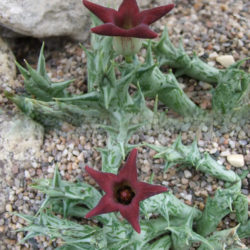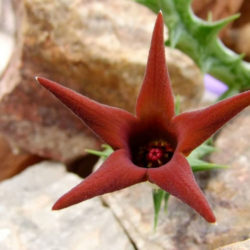Scientific Name
Orbea deflersiana (Lavranos) Bruyns
Synonym(s)
Angolluma deflersiana, Caralluma deflersiana, Ceropegia deflersiana, Pachycymbium deflersianum
Scientific Classification
Family: Apocynaceae
Subfamily: Asclepiadoideae
Tribe: Ceropegieae
Subtribe: Stapeliinae
Genus: Orbea
Description
Orbea deflersiana is a small succulent with fleshy, decumbent, branching stems with long conical tubercles joined into four thick continuous angles along the stem. The stems can grow up to 3 inches (7.5 cm) long and up to 0.6 inches (1.5 cm) thick. They are grey-green and mottled with dark green to reddish-brown.
The flowers appear solitary on a short, thick stalk, usually arising around the upper part of the branches in late summer and fall. The corolla is grey-green mottled with brown on the outside and brown-purple on the inside. It has a cylindrical tube and five ascending lobes and can reach up to 1.2 inches (3 cm) across. The fruits are long, fusiform follicles.
Origin
Orbea deflersiana is native to Saudi Arabia and Yemen. It usually grows in rocky areas in the shade of other plants.

Hardiness
USDA hardiness zone 9b to 11b: from 25 °F (−3.9 °C) to 50 °F (+10 °C).
How to Grow and Care
Several species are fairly easy to grow. Others, often those with slightly hairy stems and the more unusual flowers, are more challenging and require careful watering (with some fertilizer) during the growing season and complete water withdrawal during the winter months. A minimum winter temperature of 10°C (50°F) is acceptable, providing the soil is completely dry. A heated growing bench or incubator may help delicate plants to get through the colder months. However, many species live under shrubs in their habitat and prefer light shade rather than full sun.
A gritty compost is essential, and clay pots are advisable for the more delicate species. Some growers prefer mineral-only compost to minimize the chance of a fungal attack on the roots. A layer of grit on the compost surface prevents moisture from accumulating around the base of the stems.
Keeping Stapelias and their roots free of pests such as mealybugs is the key to success, as fungal attack often occurs due to damage to stems by insects.
See more at How to Grow and Care for Stapelia.
Links
- Back to genus Orbea
- Succupedia: Browse succulents by Scientific Name, Common Name, Genus, Family, USDA Hardiness Zone, Origin, or cacti by Genus
Photo Gallery
Click on a photo to see a larger version.


